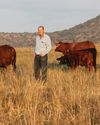Try GOLD - Free
Creep Feed For Small Stock: Distinguish Between Lambs And Kids
Stockfarm
|June 2021
The difference between creep feed for lambs and kids is substantial, says Dewald Vosloo, nutrition consultant and managing director of Saamstaan Voere in Vrede.

This distinction is mainly due to the differences in the rumen of sheep and goats. However, other fundamental differences exist that contribute to their respective creep feed requirements.
Feeding habits differ
“Firstly, we need to look at the different feeding habits of goats and sheep. Sheep graze downwards from where their gaze rests, whereas goats graze from eye level upwards. It is the reason for goats’ sensitivity to internal parasites when they are left to graze short grassland. There are virtually no parasites at their natural feeding height. Sheep, on the other hand, are adapted to short grass and therefore are more accustomed to parasitic exposure.”
Sheep were developed in Europe and, through years of adaption, can make excellent use of small grains. Goats, on the other hand, originated in the northern parts of Africa and Asia, where they evolved to make excellent use of fibrous plants. Goats are therefore well equipped to digest fibre, while sheep do the same with grain.
“Because goats are grain sensitive, you cannot include warm grain pellets in your creep feed ration as you do with sheep. Lambs are excellent utilisers of creep feed pellets, which contain almost no fibre. Kids need a creep feed pellet that is high in fibre to stimulate optimal rumen development, without high grain levels burning the rumen. This is the main difference between creep feed diets for lambs and kids.”
Creep feed management system
This story is from the June 2021 edition of Stockfarm.
Subscribe to Magzter GOLD to access thousands of curated premium stories, and 10,000+ magazines and newspapers.
Already a subscriber? Sign In
MORE STORIES FROM Stockfarm

Stockfarm
Ecovite Drifos P12 and P6: Weather resistant phosphate supplements
Over 90% of South African soils are deficient in the mineral phosphorus. The country's warm, dry climate contributes to low levels of organic matter, which in turn limits phosphorus availability to animals.
4 mins
October 2025
Stockfarm
Tick resistance raises concerns
Ticks are the cause of significant annual economic losses, primarily because of the diseases they transmit. In South Africa, the blue tick species is the main culprit.
3 mins
October 2025
Stockfarm
The next generation herd health plan
<span class=
2 mins
October 2025

Stockfarm
When FMD hits: Protocols and practices
South Africa's cattle sector faces tremendous challenges regarding biosecurity and traceability. This year, the dairy industry was among the hardest hit by foot-and-mouth (FMD) disease outbreaks in most provinces in the country, especially the Eastern Cape.
10 mins
October 2025

Stockfarm
Back to basics: Success is built on simplicity and order
We live in an age of constant noise in which we are flooded daily with information and endless decisions.
7 mins
October 2025

Stockfarm
Grassland Society presents 60th congress
The 60th Congress of the Grassland Society of Southern Africa (GSSA) was recently held in Hilton, KwaZulu-Natal, drawing around 160 delegates from across Southern Africa.
3 mins
October 2025

Stockfarm
Livestock's water requirements in intensive and extensive production systems
The Earth's total water supply is estimated at around 1 386 million km³. However, only 2,5% of this comprises freshwater. Of that small fraction, approximately 68,7% is locked away in ice and snow formations in Antarctica, the Arctic, and mountainous regions.
4 mins
October 2025
Stockfarm
Breeding values level the playing field
The production of a dairy cow is influenced by factors such as age, calving season, lactation number and stage, pregnancy status, length of her previous intercalving period (ICP), nutrition, temperature, and management.
3 mins
October 2025

Stockfarm
Boost spring pastures with effective fertilisation
Applying the right nutrients to planted pastures that are tailored to the specific plant species and local environmental conditions, can significantly boost both yield and quality. However, given the high cost of fertilisers, they must be used efficiently to ensure pastures are optimally utilised by livestock. Renier Bothma, a soil scientist at Kynoch Fertilizers, explains that rainfall is a key factor in pasture production under dryland conditions. The more it rains, the greater the pasture growth and the higher the nutrient demand for maintaining optimal yield and quality.
3 mins
October 2025

Stockfarm
WHAT'S UP?
Theft burdens agricultural growth
6 mins
October 2025
Translate
Change font size

